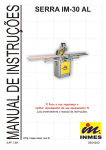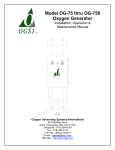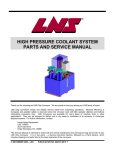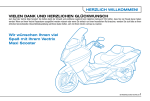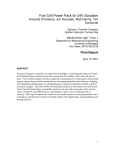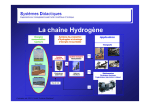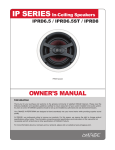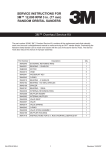Download Untitled - First Fuel Cells
Transcript
TekStack™ MANUAL AND REFERENCE INFORMATION ≥Introduction Parker has teamed with TDM Fuel Cell Technologies and the E-TEK division of PEMEAS Fuel Cell Technologies to produce the TekStak™, line of fuel cell components, stacks and accessories. This family of rugged, high performance fuel cell hardware was designed to be easily and repeatedly assembled, operated and then disassembled. Parker and our partners hope that the TekStak™ product line serves as a useful educational tool to help train the next generation of scientists, engineers, technicians and business managers who will be the key players to implement the Hydrogen Economy of tomorrow. This manual provides instructions for stack assembly and basic stack testing procedures, followed by a brief overview of Proton Exchange Membrane (PEM) fuel cells. Please refer to the included DVD for additional assembly and testing information. ≥ Stack Assembly Procedure Before beginning assembly, please identify each of the following components. ≥Stack Components ≥ 2 plastic endplates – 1 endplate with pressed-in nuts; 1 without ≥ 1 graphite cathode endplate ≥ 1 graphite anode endplate ≥ graphite bipolar plates, 1 less than the number of cells in stack ≥ membrane electrode assemblies (MEAs), 1 per cell in stack ≥ 8 socket head cap screws, size #10-32 ≥ 8 size #10 flat washers ≥ 2 brass slotted screws, size #8-32 ≥ 2 size #8-32 hex nuts ≥ 2 nickel-coated brass current collectors ≥ precut PTFE gaskets, 2 per cell in stack ≥ 2 ¼” PrestolokTM, tube fittings ≥ 2 plugs for push-to-connect fittings ≥ 8 Nitrile O-rings, size 2-010 Figure 1: Plastic Endplate Figure 2: Graphite Cathode Endplate Figure 3: Graphite Anode Endplate Figure 4: Graphite Bipolar Plate Figure 5: MEA Figure 7: Current Collector Figure 8: PTFE Gasket Figure 9: Prestolok Fitting Figure 10: Acetal Plug C* Indicates Cathode Side Figure 6: Bolt, Washer, and PEM Nut Figure 11: O-rings In addition to the included components listed, the items listed below are necessary in order to assemble the stack. These items are not included, except where noted. Flow Ports ≥Required for Assembly ≥Flat head screw driver ≥4x 1/8” diameter guide dowels (included) ≥¼” diameter assembly stand-off (included) ≥Torque wrench with 5/32” Allen head attachment ≥Powder-free rubber gloves ≥Flat, clean, non-conductive table space ≥Paper towels Figure 12: Location of Flow Ports ≥Stack Assembly Procedure – Please refer to the included DVD for additional assembly instructions 1. Insert 4 of the O-rings into the 4 O-ring grooves on the underside of each plastic endplate. Next gently press the 2 current collector plates into the recessed pockets on the plastic endplates. When pressing the current collector plate into place, it is important that the plate be inserted into the recessed pocket properly. The tab on the current collector should extend beyond the plastic endplate on the same side as ports 2 and 3. The tab should be closest to port 2. If the current collector plate is misaligned, the stack will leak when assembled, resulting in a potentially hazardous situation and poor stack performance. 2. One plastic endplate has nuts pressed into the bolt holes. Take this plate and lay it flat on the table so the Parker logo faces down. 3. Insert the 4 - 1/8”-diameter plastic assembly dowels into the flow ports of the plastic endplate. The flow ports are the small diameter ports located within the O-ring grooves. 4. Gently slide the graphite anode endplate over the 1/8” dowels, then lower it so that it rests on top of the current collector. 5. Slide a white PTFE gasket over the dowels so that it rests on top of the graphite anode end plate. 6. Carefully slide an MEA over the dowels and on top of the PTFE gasket. It is very important that the cathode side of the MEA—marked with a “C” —faces up, away from the flow field on the anode endplate. Note: As the stack is used, the “C” written on each MEA may fade. During disassembly, identify and mark the cathode side of the MEA so as to allow for proper reassembly. To mark the MEA, use a felt tipped pen. 7. Slide another PTFE gasket on top of the MEA, again using the dowels for positioning. 8. If assembling a 1 cell stack, ignore this step and go to step 10. Otherwise, slide a graphite bipolar plate over the dowels and on top of the PTFE gasket. Ensure that the serpentine flow field (the hydrogen flow channels) is facing up and that the notch in the bipolar plate lines up with the notch in the graphite anode end plate. Align the parallel flow channels on the face of the plate so that the flow channels are perpendicular to the tab on the current collector plate. 9. Repeat steps 6-9 until there are no additional MEAs to be added to the stack. After positioning the final MEA and PTFE gasket, add the graphite cathode endplate rather than a bipolar plate. Note: At this point, there should not be any additional bipolar plates, PTFE gaskets, or MEAs) Again, use the dowels to slide the plate into place, ensuring that the notches are aligned and the serpentine flow field faces downward. Figure 13: MEA positioning 10. The stack assembly will be completed by positioning the second plastic endplate and using the stack bolts to fasten the stack together. Begin by properly aligning the plastic endplates. If the plastic endplates are aligned correctly, the current collector tabs should protrude from the same side of the stack and both tabs should be visible when looking at the stack from above. This ensures that both current collectors are properly seated in the plastic endplate and that the flow ports are in the correct positions. For a visual example of proper alignment, refer to the image of the assembled stack included at the end of this manual. This image shows how the current collector plates will line up when the stack has been assembled properly. Next, carefully remove the 4 assembly dowels from the stack as necessary to slide the plastic endplate into place. After positioning the endplate, reinsert the dowels through the two open ports (ports 3 and 4). Align Notches Figure 14: Notch alignment 11. Insert the 8 socket-head cap screws into the bolt holes and into the pressed- in nuts on the opposite endplate. Ensure that the graphite plates are still properly aligned prior to tightening the screws. The socket-head cap screws should be tightened in an alternating diagonal pattern to a maximum torque of 8 in.-lbs using a torque limiting wrench with a 5/32” Allen head attachment. To assist in proper tightening of the 8 screws, the ¼” diameter height gauge dowel can be used. When all the bolts are tightened properly, the height gauge dowel should fit in between the two plastic endplates with little resistance. If the height gauge dowel does not fit easily into the space between plastic endplates, the assembly screws should be loosened. 12. With the bolts tightened to 6-8 in.-lbs of torque, the assembly dowels and height gauge dowel may be removed. The brass screws may now be passed through the hole in the current collector tabs and tightened into place using the brass #8-32 nuts. These brass screws can be used to connect electrical leads to the stack for testing. 13. If push-to-connect fittings are not integrated into the plastic endplates, then threaded push-toconnect fittings have been included in the kit. If applicable, screw the threaded fittings into the appropriate ports on the endplate. The fuel inlet fitting should be screwed into port #4 on the endplate with the pressed in nuts; the fuel exhaust fitting should be inserted into port #3 on the opposite endplate. Figure 15: Bolt tightening pattern A.Test Infrastructure Fuel cell testing requires control of two different but equally important set of parameters—the reactant flow and the electronic load. Both groups are addressed briefly below. In all cases, ensure that whatever test infrastructure is put in place is in compliance with all local safety codes and facility regulations. Warning: Normal precautions associated with hydrogen must be taken. DO NOT use hydrogen in a sealed or unvented room. DO NOT use in close proximity to open flame or other ignition sources. Observe all local safety codes and regulations. Reactant Flow Control Infrastructure Fuel Supply Options Two methods that can be used to control the fuel supply to the stack. They are known as “dead-ended” and “continuous flow.” Dead-ended flow is based upon pressure regulation. Continuous flow is based upon flow rate control. Regardless of the option selected, the fuel source can be a pressurized hydrogen cylinder, a charged metal hydride cylinder, or a hydrogen generator. “High purity” grade (99.995% or greater) or better will ensure the catalysts in the MEAs are not contaminated by impurities in the fuel stream. If a cylinder of compressed hydrogen gas is not used as the fuel source, it is important that a filter be inserted into the fuel supply line immediately downstream of the hydrogen source to prevent contaminants from poisoning the MEAs. This is especially true if alternative hydrogen storage/supply options, such as a hydride cylinder or sodium borohydride, are employed. For both dead-ended and continuous-flow fuel supply options, the maximum fuel supply pressure is 3 psi. Two-stage regulators can be used to reduce the fuel pressure to an appropriate level. The hydrogen source must be connected to the stack and other infrastructure through appropriate tubing and tube fittings. The stack comes with push-toconnect fittings for ¼” OD flexible tubing. The tubing used should be semi-rigid and be selected based upon permeability of hydrogen gas. Recommended tubing materials include PTFE, polyurethane, polypropylene or PVC. Dead-ended Fuel Supply If dead-ended fuel flow is selected, precise pressure regulators and gauges will be required to achieve the necessary control over the fuel delivery pressure. The recommended operating pressure range is between 0.5 and 2 psig. If hydrogen is supplied via a cylinder of compressed gas, it is likely that two or more regulators will be needed to reduce the pressure seen by the stack to the appropriate range. The hydrogen outlet of the stack should be blocked with one of the included acetal plugs. CAUTION: DO NOT over pressurize the stack. Hydrogen pressure should never exceed 3 psi. Figure 16: Dead-ended H2 flow setup For dead-ended operation, no flow controller/meter is required, though one may be used to measure the hydrogen flow into the stack. With no current load on the stack, the fuel flow rate should be zero. A non-zero flow rate at open circuit indicates leaks within fuel supply line. If the leak rate at open circuit is found to be greater than approximately 15 mL/min, then steps should be taken to reduce the leak rate, such as checking that all fittings are sufficiently tight and that the stack is assembled properly. In this configuration, humidification of the hydrogen stream is optional. Reactant humidification helps the stack to attain optimum performance. If the hydrogen stream is humidified, it is necessary that the fuel line is purged approximately every 30 minutes to prevent water build up on the anode of the cells. Note: Purging the stack should be done carefully and in a well-ventilated area. If the hydrogen stream is not humidified, then no purge is required. Continuous Flow Fuel Supply If a continuous flow configuration is used, fuel supply will be managed via a flow controller or a flow meter combined with a valve. The flow meter/controller used can be a simple rotameter (if a hydrogen calibration scale is available) or a more sophisticated digital flow controller complete with computer control options. The required range of the flow meter/controller will vary depending upon the number of cells in the stack and the maximum current load to be placed on the fuel cell stack. As a general guideline, the hydrogen flow required (assuming that all hydrogen reacts with oxygen to form water) is 7.5 ccm/A/cell at room temperature and standard pressure. Refer to section III for information on how to calculate the required hydrogen flow rate for a specific test scenario. In the continuous flow configuration, it is still necessary to regulate the hydrogen supply pressure such that the stack does not see fuel pressures above 3 psig. It is necessary that the fuel stream be humidified prior to introduction to the stack. Ideally, the stream would be saturated prior to introduction to the stack. If budgetary constraints prevent the use of an appropriately sized humidifier, a bubbler or diffuser with deionized water may be used to provide a humidified, but not saturated, hydrogen stream. Air Supply Options The air supply method used is dictated by the design of the stack; specifically, it is dictated by the flow fields on the cathode sides of each graphite plate. If the plates have several parallel air flow channels, the stack is “air breathing.” If the flow pattern is serpentine, then the stack requires a pressurized air supply. Air Breathing The term “air breathing” is used to indicate that the stack is supplied with air in a passive manner. That is, there is no requirement for any air supply infrastructure—the stack will produce power as long as fuel is supplied to it. However, the user may wish to use a small fan to realize slightly improved cell performance. If this is the case, a DC fan can be positioned in front of the air flow channels in the graphite plates. If the stack is large enough that it can supply the fan with sufficient power, the fan can be powered off of the stack by connecting the positive lead from the fan to the stack cathode (air electrode) and the negative lead to the stack anode (hydrogen electrode). Alternatively, a DC power supply set to the proper voltage can be used to run the fan. Note: If the stack is used to power the fan, any test data collected should reflect this parasitic load on the stack. If the stack to be tested requires a forced air supply, the requirements are similar for pressure and flow control of hydrogen, in that pressure regulator(s) and a flow controller or a flow meter and an adjustable valve are required. The primary difference is in the flow rate of air selected. Again, the user should determine the appropriate air flow rate for the test that he or she wishes to run. In this case, the general rule is that the oxygen required (assuming that all oxygen reacts with hydrogen to form water) is 3.75 ccm/A/cell at room temperature and standard pressure. However, oxygen comprises only about 20% of the air, so the air flow required, again assuming complete oxygen conversion, is 18.75 ccm/A/cell. It is also necessary that the air stream be cleaned by a 10 micron filter (or better). The air should then be passed through a desiccator to dry the air prior to passing through the flow controller. Downstream from the flow control device, the air must be humidified to the maximum extent possible, as discussed above in relation to fuel humidification in continuous flow configuration. Caution: Prevent electric shock through the use of proper plugs and wires and good earth ground connections. Ensure that no bare wire is exposed. Follow all safety instructions provided by the electronic load manufacturer. In a laboratory setting, fuel cell stacks are commonly tested using DC electronic loads to control the current load placed on the stack. For ongoing stack testing, it is advisable to use a DC load because of the precise control and measurement offered, as well as the ability to communicate with a properly equipped data acquisition system. The DC load selected must have current, power, and voltage ranges that are appropriate for the stack or stacks to be tested. Often, the lower end of the voltage range of a DC electronic load is greater than 0 V; examples of some common lower voltage limits include 5 V and 1.5 V. If it is necessary to test the stack while the operating voltage is less than this lower limit, a DC power supply with an appropriate current range can be put in series with the fuel cell stack to boost the voltage seen by the DC load. This “extra” voltage can then be subtracted from the total voltage measured by the load to determine the stack voltage. Please consult the DC load supplier for selection and integration of an appropriate power supply, if this step is necessary. If a power supply is added in series to the stack, it is recommended that the power supply comes after the fuel cell stack; that is, the stack cathode (positive) lead should be connected to the negative lead of the power supply. The positive lead of the power supply should be connected to the electronic load. If the stack testing requirements are such that a DC electronic load is not necessary, then the stack can be tested using digital multimeters (DMMs) and combinations of power resistors. When selecting power resistors, ensure that they are rated for a proper power level (P = I2R). One DMM should be put in parallel with the fuel cell stack and used to measure voltage; another should be placed in series between the stack and the load and used to measure current. The combination of power resistors can then be varied to adjust the load on the stack. Figure 18: Simplified system setup B.Test Preparation/Set-up As discussed above, there are several ways that reactant streams may be supplied to the fuel cell stack. Here, the test prep procedure is described for each of those flow scenarios. If the hydrogen outlet is to be closed off so that the stack is “dead-ended,” then hydrogen flow will be controlled by a pressure regulator. Begin by connecting the hydrogen supply to the stack via pressure regulators. If a flow controller is in the fuel line, set it to full flow. Turn the pressure regulator(s) down to fully open (no pressure). Cap off the fuel outlet of the stack with the included plug. Turn on the hydrogen source--either by opening the pressurized cylinder or by activating the hydrogen generator. Slowly increase the pressure on the regulator closest to the hydrogen supply. If only one regulator is used, set the pressure seen by the stack (i.e. downstream from the regulator and upstream of the stack) to between 0.3 and 2 psi. Record the fuel pressure. Warning: Hydrogen pressure should never exceed 3 psi. Immediately turn off hydrogen supply and relieve hydrogen pressure in a WELL VENTILATED area if a pressure spike occurs. If a series of regulators is used to supply fuel to the stack at an appropriate level, then set the pressure in each regulator sequentially, beginning with the regulator closest to the fuel supply. Make sure that each regulator receives an input pressure within its operating range. Increase the pressure at each regulator from 0 very slowly. If the pressure exceeds the recommended range for a regulator or the stack itself, carefully vent the hydrogen and lower the pressure setting on the regulator to 0. Turn the hydrogen supply back on and slowly increase the pressure until it is in the appropriate range. Note: If the fuel supply is humidified and the stack is dead-ended, then it will be necessary to purge the fuel side of the stack by opening the fuel outlet and allowing water to be drained. This should be done approximately every 30 minutes. Setup for Continuous Flow Testing Connect the fuel supply to pressure regulators such that the supply pressure is no more than 2 psi. Install a flow controller or a flow meter and proportional valve downstream of the last regulator. Close the controller or valve so that there is no flow. Ensure that the hydrogen outlet is open. Slowly open the controller or valve to increase the hydrogen flow rate to an appropriate level based upon the tests to be conducted. Assuming that the hydrogen is Ultra-High Purity (UHP) or chemically pure, then no filtration is required. Otherwise, be sure to use a 10 micron (or finer) filter to eliminate impurities. Downstream of the flow controller, the hydrogen should be hydrated as described above. Air Flow Setup If the stack is air-breathing, no setup is required. As an option, a small fan can be connected to a power supply to increase the air flow through the fuel cell stack. If the stack requires a pressurized air supply, set up the air supply in similar fashion to how the hydrogen supply is set up for continuous flow testing, using pressure regulators and a flow controller. If a shop air supply is used, it is important that the gas be dried and be sure to use a 10 micron (or finer) filter to eliminate impurities. After the air has passed through the flow controller, it should be humidified using an appropriately sized humidifier or bubbler. Electrical Setup In order to measure the electrical performance of the fuel cell stack, the stack cathode (air electrode) should be connected to the positive terminal of the electronic load and the anode should be connected to the negative terminal of the load. If using a four point measurement system, the positive voltage sense lead should be connected to the cathode and the negative sense lead should be connected to the anode. Once fuel flow has been initiated, the load can be turned on. Ensure that the current load is off (set to 0 A). C.Common Testing Procedures There are many ways to test a fuel cell stack depending upon what sort of information is sought. This section will introduce the break-in procedure recommended in order to reach maximum performance and the most common simple tests. Additional tests can be designed by the user in order to provide data to answer specific questions. After the stack has been assembled for the first time, it is necessary to “break-in” the membranes in order to achieve optimal performance. The point of this process is to hydrate the membranes so as to maximize their ionic conductivity. This is done by introducing humidified reactant flow to the stack. It is recommended that the fuel flow be dead-ended. Remember to occasionally purge at the fuel outlet to drain excess water. Once an Open-Circuit Voltage (OCV) of approximately 0.9 – 1 V/cell is observed, slowly begin increasing the current load on the stack from 0 A up to a maximum of 1 A in steps of 0.1 A. Increment the load once voltage has stabilized from the previous increase. Since the goal is to fully hydrate the membranes, this will be achieved most quickly by pulling the maximum current load that is safe for the stack. A safe level is best determined by the average cell voltage. For brief periods (less than 2 minutes), it is acceptable for the stack to operate with an average cell voltage of 0.4 V/cell. For longer periods of time, a safe minimum average cell voltage is 0.55 V/cell during break-in. Once the stack voltage has stabilized at this level, maintain the current load for a period of two to eight hours. The time required to break-in the stack is dependent upon how high the current load is. One convenient way to determine if break-in is complete is to check the stack voltage every few hours at a specific current level, such as 1 A or 1.5 A. If the stack voltage has not changed substantially from the previously measured operating voltage, the break-in process may be considered complete. It is strongly recommended that the stack be monitored during the break-in period. However, if the stack is to be left unattended, then fuel humidification will need to be discontinued to prevent the anode flow channels from flooding while the stack is unattended. Alternatively, the stack could be run within a continuous flow configuration and humidification may be continued. After break-in is complete, actual testing may begin. The most common test for a fuel cell or a fuel cell stack is the polarization curve. Polarization curves are also known as V-I or V-j curves as they are plots of the stack voltage against the current load (I) or current density (j). A second common plot that typically accompanies the V-j curve is the power density curve, which plots power density (the product of stack voltage and current density) against current density. One method for collecting V-j and power density curves is briefly introduced here; for additional information, the reader is encouraged to refer to the multitude of peerreviewed journals and reference texts such as Fuel Cell Systems Explained and The Fuel Cell Handbook. 1.Begin flowing humidified fuel to the stack using either dead-ended or continuous-flow methods as previously described. If desired, use a small fan to actively supply air to the stack. The stack temperature should also be monitored using a thermocouple. 2.Turn on the electronic load and set the current load to 0 A (open circuit). Allow the stack voltage to stabilize and record this voltage. This is the OCV. If the stack is being operated dead-ended, note the hydrogen flow with no load. Under these conditions, if a fuel flow is indicated by the meter/controller, it is most likely due to a hydrogen leak within the system. 3.Increase the current load on the stack to 0.1 A and allow the stack voltage to stabilize. Record the stack voltage and the fuel flow rate. The stack voltage should take about a minute to reach a stable level. 4.Continue to increase the stack current in small increments until the power output of the stack has begun to decrease as current increases or the stack voltage does not stabilize at a particular current load. 5.Using the same current increment, decrease the current load on the stack and record stack voltage as it stabilizes. This will allow for the quantification of any hysteresis effects. 6.Having done a complete current sweep, beginning and ending at 0 A, now the data must be plotted. To calculate the current density, simply take the 0.100 4.00 0.080 3.00 0.060 2.00 0.040 1.00 0.020 0.00 0.00 (W/cm 2) 5.00 Cell Power Density Stack Potential (V) active area of an individual MEA and divide the current load by this value. For example, a 1 A load on a 10 cm2 MEA is a current density of 100 mA/cm2. Plot these current densities on the x-axis. Plot the stack voltage on the y-axis. Take the product of the current density and stack voltage to calculate the stack power density, which will have units of W/cm2 or mW/cm2. It is common to plot the power density curve on the same graph as the V-j curve, using a second y-axis so that the stack current and power density are properly scaled. 0.000 0.02 0.04 0.06 0.08 0.10 0.12 0.14 0.16 0.18 0.20 2 Current Density (A/cm ) Forced Air Supply - V Passive Air Supply - V Forced Air Supply - Power Passive Air Supply - Power Figure 19: Example V-j and Power Density curves Several parameters can be varied to yield a significant number of V-j curves for basic analysis—including running the stack with continuous fuel flow versus dead-ended fuel flow, running the stack with humidified versus dry fuel, testing the stack with a passive air supply versus a forced air supply, varying the fuel flow rate (continuous flow) or fuel pressure (dead-ended), and varying stack temperature. A.Testing Precautions To ensure the safety of the testers and the product, precautions must be taken when testing a fuel cell stack. With regard to the test system, this includes ensuring that the hydrogen gas is properly vented from the area. To avoid damaging the stack during testing, there are several other precautions that should be taken. The first is to avoid operating the stack at very low voltage. Do not ever short circuit the fuel cell stack. Do not allow the stack operate at level such that the average operating voltage of the individual cells is less than 0.2 V for a hydrogen fueled stack. A second precaution that should be taken to ensure proper stack operation is to introduce only humidified (preferably saturated) gases to the stack. If localized dry out of the MEA occurs, small holes could develop in the membrane material due to local hot spots. These holes would allow hydrogen and air to mix, resulting in a dangerous situation. Caution: Confirm that MEAs are in good condition prior to exposure to hydrogen. Conduct a leak check to prevent mixing of hydrogen and ambient air. III.P roton Exchange Membrane Fuel Cells Reference Information This section seeks to provide a general introduction to basic concepts related to basic operation of fuel cells and how to quantify the performance of a fuel cell. For more detailed information, please refer to more in-depth fuel cell references, such as Fuel Cell Systems Explained and The Fuel Cell Handbook. On a fundamental level, a PEM fuel cell is a device that converts hydrogen and oxygen into water and electricity. As shown in the schematic below, hydrogen molecules flow to the anode of the MEA. Here, they are split into electrons and positive ions. The positive ions migrate through the membrane material; the electrons cannot pass through the membrane, so they are forced to pass through the load (e.g. a light bulb) before the electrons reach the cathode of the MEA. At the cathode, the electrons combine with the positive ions (positive hydrogen ions or protons) that have passed through the membrane and oxygen molecules from the air to form water. This completes the electrical circuit, resulting in electrical power from the stack. A fuel cell’s performance is primarily defined by the amount of fuel and air required to produce a certain amount of power. More specifically, the amount of reactants necessary to yield a specific cell or stack voltage at a specific current density defines a fuel cell’s performance. The voltage at which a fuel cell functions is known as the operating voltage. The operating voltage can range from 0 V up to a theoretical maximum known as the Nernst Potential. The Nernst Potential is, in essence, the electrical potential difference (voltage) that would result from a given chemical reaction, such as the combination of hydrogen and oxygen, at very specific conditions. In the case of the formation of water from hydrogen and oxygen at standard temperature and pressure, the Nernst Potential is approximately 1.2 V. The voltage efficiency of a single cell can therefore be calculated by dividing the operating voltage by this voltage. For an multi-cell stack, voltage efficiency is calculated by taking the stack voltage and dividing it by the Nernst Potential multiplied by the number of cells in the stack. Similarly, the current load on a stack is also an important parameter used to measure the performance of a fuel cell. The maximum current, or ideal current, is dictated by the amount of fuel and air supply. The ideal current can be calculated using Faraday’s current law, which states that the ideal current is proportional to the reactant flow rate multiplied by the number of electrons being transferred in the reaction. Detailed calculations will not be carried out here, but using Faraday’s current law, it can be shown that a 1 A current is equivalent to 7.5 mL/min H2 at room temperature and standard pressure. Based on the total current produced by the stack and fuel flow going into the stack, the fuel utilization can be calculated. Fuel utilization is defined as the ratio of actual current produced to the ideal current that could be produced from a given fuel flow rate. For instance, if the fuel flow rate is set at 15 mL/min and the current load produced by the stack is 1.5 A, the fuel utilization is 75% (1.5 A actual current / 2 A ideal current). The inverse of utilization is, mathematically, the ratio of ideal current to actual current; this is referred to as NOS or “stoics.” Air/oxygen supply is commonly considered in terms of stoics, which effectively describe the excess reactant supplied. For example, if the air is supplied at 2 stoics, this means that there is exactly twice as much oxygen flowing into the stack as is required for a given current load. For air breathing stacks, the number of stoics is not reported. IV.C ustomer Support Contact your authorized Parker Distributor, or if you purchased the product direct from Parker, contact us at: Parker Energy Systems Parker Hannifin Corporation 95 Edgewood Avenue New Britain, CT 06051-4100 Tel: 1-877-217-4501 Fax: 1-866-781-7426 [email protected] V. Introduction to Parker Energy Systems and Parker Hannifin Corporation About Parker Hannifin Headquartered in Cleveland, Ohio with over 200 locations in 45 countries, Parker Hannifin Corporation is a world-leading manufacturer of engineered components and systems for a wide range of fluid control applications. Parker appreciates the far-reaching benefits of a hydrogen-based economy and is well positioned to help the fuel cell industry along the challenging road towards commercialization. About Parker Energy Systems Parker’s involvement with fuel cell technology is a natural outgrowth of its existing product technologies and engineering capabilities. Parker already manufactures most of the individual fittings, valves, hoses, seals and filters required to meet balance of plant needs for mobile and stationary fuel cell power plants. However, to achieve the kind of dramatic cost reductions required for the commercialization of fuel cell products, Parker created its Energy Systems Business Unit to combine components with high efficiency motors, pumps, compressors and programmable electronic controls to deliver complete system solutions. Through Parker Energy Systems (PES), Parker offers humidifiers, fuel cell stack assemblies, cathode air compressors, hydrogen circulators, flexible stainless steel tubing, filtration products, control valves, liquid pumps, pressure regulators & transducers, positioning tables, PEM fuel cell stack components, seals, manifolds, fittings and tubing. Parker’s recent collaboration with Vectrix Corporation to design and build a prototype Fuel Cell/Electric Hybrid Motorbike is an example of PES’s system integration capabilities. Under PES’s guidance, ten Parker divisions provided product and engineering assistance to a start-up company (Vectrix) launching the world’s first hybrid fuel cell/electric scooter. The scooters will be sold in Europe where high priced gasoline, lack of parking space and even government taxes and outright bans on internal combustion engines in some cities should make them very popular. Additionally, PES is working with fuel cell manufacturers producing power units for public transportation, utility companies and residential systems. Parker believes that it’s incumbent on manufacturers to think ahead, to provide for the future of more than just our industries. Oil won’t last forever. Solar, wind and fuel cell technologies, in addition to being environmentally friendlier right now, should be developed against the day when they will be urgently needed to provide the power many take for granted. To be ready for this day, tomorrow’s engineers and scientists must begin working with these technologies now. The TekStak product line is intended to provide students from high school through university-level with the ability to assemble and test customizable fuel cell stacks. To enhance the educational opportunity for students, the TekStak product line includes a range of balance of plant components that can be combined with the fuel cell stacks, allowing students to construct their own complete fuel cell system. ≥Parker Energy Systems is preparing the world. Today. VII.Recommended Reading The following is a brief list of recommended sources for additional information relating to fuel cells and fuel cell systems. Books Fuel Cell Systems Explained, Second Edition by James Larminie and Andrew Dicks, John Wiley & Sons, Ltd. 2003 Fuel Cell Handbook (Seventh Edition) by EG&G Technical Services, Inc. for the National Energy Technology Lab (NETL). 2004 Available online at http://www.netl.doe.gov/seca/pubs/FCHandbook7.pdf Websites www.parker.com/fuelcells - Homepage of Parker Energy Systems www.fuelcells.org - Contains a wide variety of information relating to fuel cells www.nrel.gov - Homepage of the National Renewable Energy Lab (DOE) www.netl.doe.gov - Homepage of the National Energy Technology Lab (DOE) www.usfcc.com - Homepage of the US Fuel Cell Council (USFCC) For more information, please visit: parker.com/fuelcells FC0616 May 2006




























